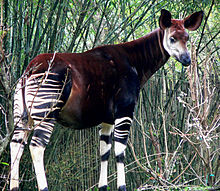List of megafauna discovered in modern times
This article needs additional citations for verification. (April 2009) |
The following is a list of megafauna discovered by science since the beginning of the 19th century (with their respective date of discovery). Some of these may have been known to native peoples or reported anecdotally but had not been generally acknowledged as confirmed by the scientific world, until conclusive evidence was obtained for formal studies. In other cases, certain animals were initially considered hoaxes - similar to the initial reception of mounted specimens of the duck-billed platypus Ornithorhynchus anatinus [1] in late 18th-century Europe.
The definition of megafauna varies, but this list includes some of the more notable examples.
Megafauna believed extinct, but rediscovered



- Coelacanth (Latimeria chalumnae), 1938[2]
- Chacoan peccary (Catagonus wagneri), 1975[3]
- Burchell's zebra (Equus quagga burchellii), 2004[4]
Megafauna previously unknown from the fossil record
- Western grey kangaroo Macropus fuliginosus (1817)
- Malayan tapir Tapirus indicus (1819)
- Red kangaroo Macropus rufus (1822)
- Lowland anoa Bubalus depressicornis (1827)
- Mountain tapir Tapirus pinchaque (1829)
- Northern cassowary Casuarius unappendiculatus (1860)
- Seven-arm octopus Haliphron atlanticus [5][6] (1861)
- Baird's tapir Tapirus bairdii (1865)
- Varanus salvadorii (1878)[7][8][9][10]
- Mountain gorilla Gorilla beringei (1902)
- Giant forest hog Hylochoerus meinertzhageni (1904)
- Komodo dragon Varanus komodoensis (1910)[11]
- Mountain anoa Bubalus quarlesi (1910)
- Mountain nyala Tragelaphus buxtoni (1910)
- Colossal squid Mesonychoteuthis hamiltoni (1925)
- Bonobo Pan paniscus (1928)
- Kouprey Bos sauveli (1937)
- Megamouth shark Megachasma pelagios (1976)
- Saola / Vu Quang ox Pseudoryx nghetinhensis (1992)[12]
- Giant muntjac Megamuntiacus vuquangensis (1994)
- Bigfin squid several in the genus Magnapinna (1998)
- Omura's Whale Balaenoptera omurai (2003) [13]
- New unnamed species of hammerhead shark (2004)[14]
- Myanmar snub-nosed monkey Rhinopithecus strykeri (2010)
- Kabomani tapir Tapirus kabomani (2013)
Megafauna initially believed to have been fictitious or hoaxes
- Giant panda Ailuropoda melanoleuca known to the Chinese for centuries, but only discovered by westerners in 1869[15]
- Giant squid Architeuthis dux (1878) (first seen live 2005)[16]
- Przewalski's horse Equus ferus przewalskii (1881 - current wild population descended from zoo breeding since 1945)[17]
- Okapi Okapia johnstoni (1901)
- Hoan Kiem turtle Rafetus leloii (1967)
- Grizzly–polar bear hybrid (2006)[18]
Status unclear
- Sumatran muntjac Muntiacus montanus (1918)
- Nangchen horse (1993)
- Riwoche horse (1995) [19] Horses previously unknown to the outside world, resembling horses depicted in cave paintings, was found in a remote valley in Tibet.[19]
- Giant peccary Pecari maximus (2007)
See also
References
- ^ Duckbilled Platypus Museum of Hoaxes.
- ^ "New 'living fossil' identified". Sci/Tech. BBC News. 1999-03-25. Retrieved 2009-01-03.
The first living coelacanth (Latimeria chalumnae) was discovered in 1938 when marine biologists hailed the fish as a "living fossil" - an animal that has existed virtually unchanged since it first appeared over 400 million years ago.
- ^ Wetzel, R. M., Dubos, R. E., Martin, R. L. & Myers, P. (1975). "Catagonus, an 'extinct' peccary alive in Paraguay." Science 189, 379-381.
- ^ Groves, C.P. & Bell, H.B. 2004. New investigations on the taxonomy of the zebras genus Equus, subgenus Hippotigris. Mammalian Biology. 69: 182-196.
- ^ "Giant octopus puzzles scientists". BBC News. 2002-03-28. Retrieved 2010-05-08.
- ^ http://www.tonmo.com/science/public/haliphron.pdf
- ^ King, Ruth Allen; Pianka, Eric R.; King, Dennis (2004). Varanoid Lizards of the World. Bloomington: Indiana University Press. ISBN 0-253-34366-6.
- ^ Mackal, Roy P. (1987). A Living Dinosaur?: In Search of Mokele-Mbembe. Leiden: E.J. Brill. ISBN 90-04-08543-2.
- ^ Ciofi, Claudio (1999-03-01). "The Komodo Dragon". Scientific American. Retrieved 2008-08-21.
- ^ "Crocodile Monitor". Saint Louis Zoo. Retrieved 2008-08-21.
- ^ Daily Mail - Should we really be scared of the Kimodo dragon?
- ^ http://www.redlist.org/search/details.php?species=18597
- ^ http://www.bbc.com/earth/story/20151030-there-is-a-whale-longer-than-any-orca-and-we-missed-it
- ^ "Scientist Finds 'Genetically Distinct' Shark". PhysOrg.com. Retrieved June 2006.
{{cite web}}: Check date values in:|accessdate=(help) - ^ Wildt, David E. (27 July 2006). Giant Pandas: Biology, Veterinary Medicine and Management. Cambridge University Press. pp. 7–8. ISBN 978-0-521-83295-3.
- ^ "Live giant squid caught on camera". BBC News. 28 September 2005. Retrieved 22 April 2012.
- ^ "An extraordinary return from the brink of extinction for worlds last wild horse" ZSL Living Conservation, December 19, 2005.
- ^ "Wild find: Half grizzly, half polar bear: Hunter bags what expert 'never thought would happen' in wild". MSNBC.MSN.com. May 11, 2006. Retrieved 2006-05-14.
- ^ a b "Tibetan discovery is 'horse of a different color'". CNN. November 17, 1995. Retrieved 2008-07-22.
